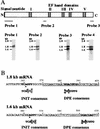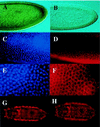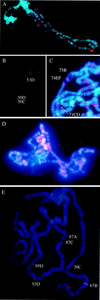DNA supercoiling factor localizes to puffs on polytene chromosomes in Drosophila melanogaster
- PMID: 9774687
- PMCID: PMC109257
- DOI: 10.1128/MCB.18.11.6737
DNA supercoiling factor localizes to puffs on polytene chromosomes in Drosophila melanogaster
Abstract
DNA supercoiling factor (SCF) was first identified in silkworm as a protein that generates negative supercoils in DNA in conjunction with eukaryotic topoisomerase II. To analyze the in vivo role of the factor, we cloned a cDNA encoding Drosophila melanogaster SCF. Northern analysis revealed 1.6- and 1.8-kb mRNAs throughout development. The longer mRNA contains an open reading frame that shares homology with mouse reticulocalbin whereas the shorter one encodes a truncated version lacking the N-terminal signal peptide-like sequence. An antibody against SCF detected a 45-kDa protein in the cytoplasmic fraction and a 30-kDa protein in the nuclear fraction of embryonic extracts. Immunoprecipitation suggests that the 30-kDa protein interacts with topoisomerase II in the nucleus, and hence that it is a functional form of SCF. Immunostaining of blastoderm embryos showed that SCF is present in nuclei during interphase but is excluded from mitotic chromosomes. In larvae, the antibody stained the nuclei of several tissues including a posterior part of the salivary gland. This latter staining was associated with natural or ecdysteroid-induced puffs on polytene chromosomes. Upon heat treatment of larvae, the staining on the endogenous puffs disappeared, and strong staining appeared on heat shock puffs. These results implicate SCF in gene expression.
Figures








References
-
- Andrew D J, Scott M T. Immunological methods for mapping protein distribution on polytene chromosomes. Methods Cell Biol. 1994;14:353–370. - PubMed
-
- Androphy E J, Schiller J T, Lowy D R. Identification of the protein encoded by the E6 transforming gene of bovine papillomavirus. Science. 1985;230:442–445. - PubMed
-
- Ashburner M. Patterns of puffing activity in the salivary gland chromosomes of Drosophila. VI. Induction by ecdysone in salivary glands of Drosophila melanogaster cultured in vitro. Chromosoma. 1972;38:255–281. - PubMed
-
- Bhat M A, Philp A V, Glover D M, Bellen H J. Chromatid segregation at anaphase requires the barren product, a novel chromosome-associated protein that interacts with topoisomerase II. Cell. 1996;87:1103–1114. - PubMed
Publication types
MeSH terms
Substances
Associated data
- Actions
- Actions
LinkOut - more resources
Full Text Sources
Molecular Biology Databases
